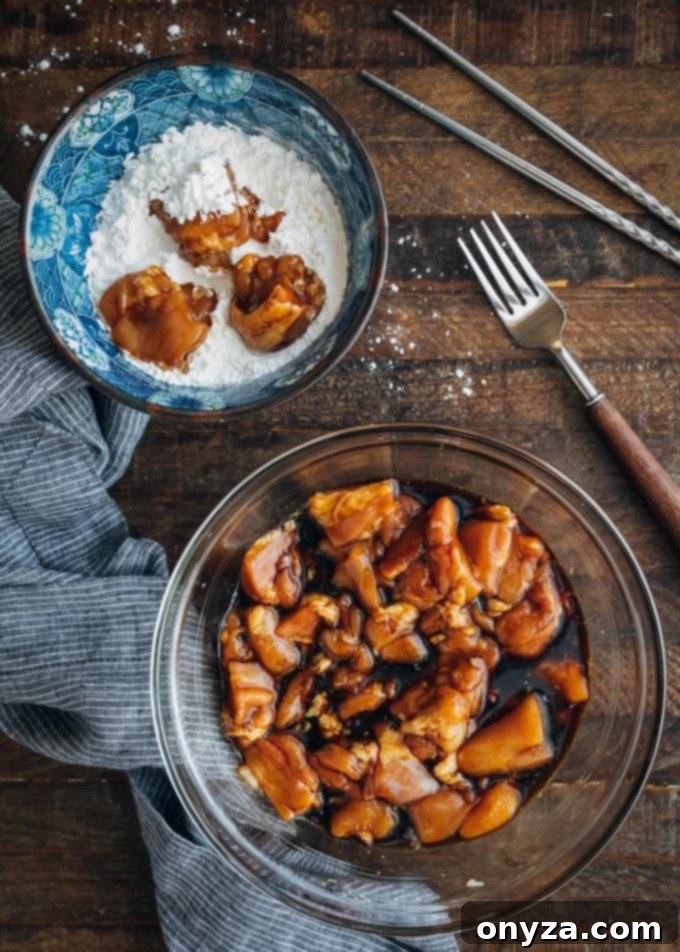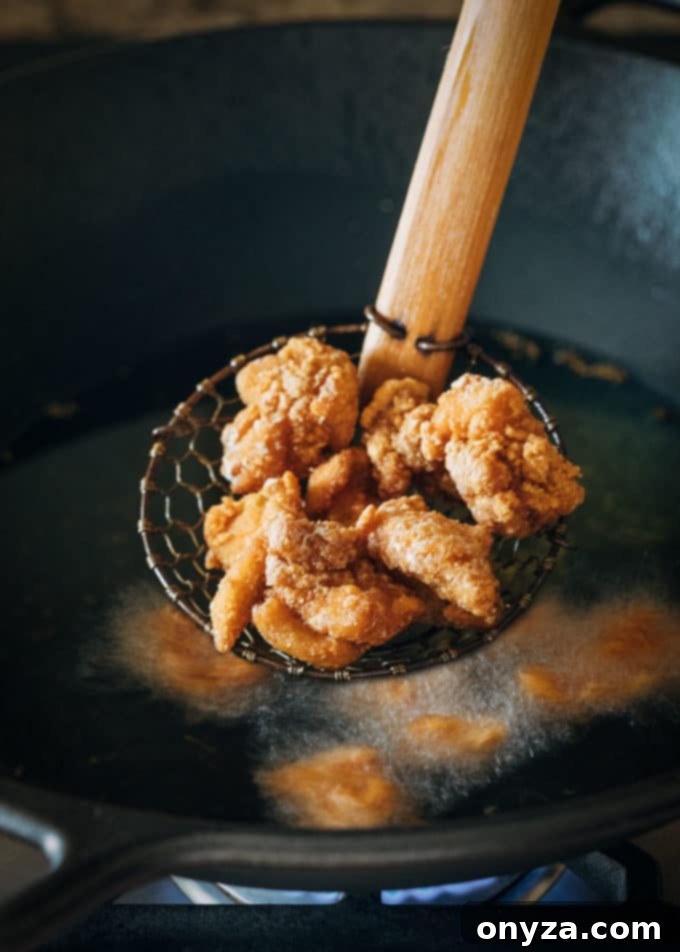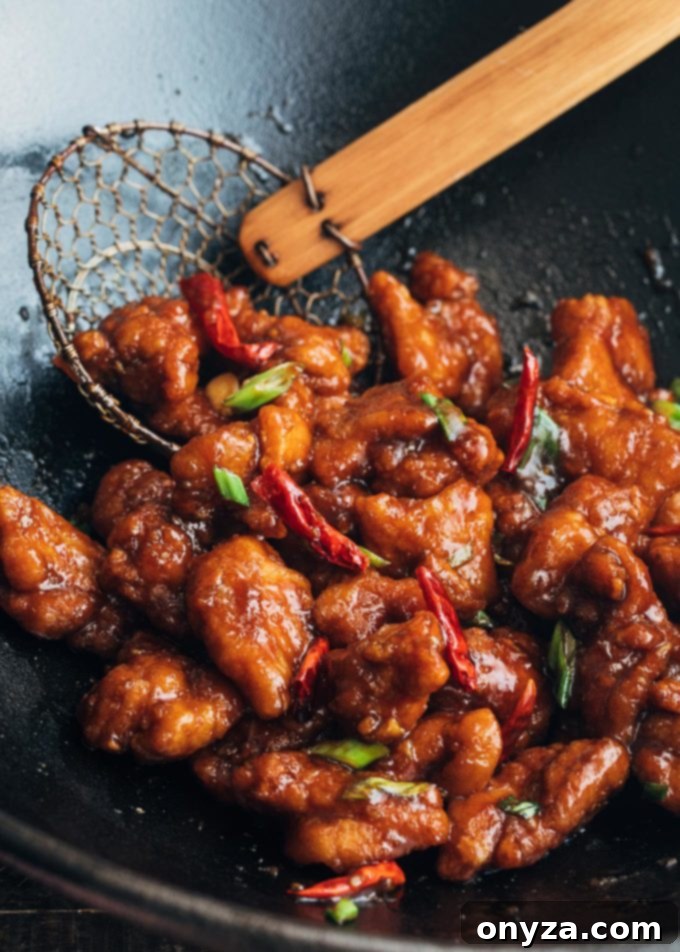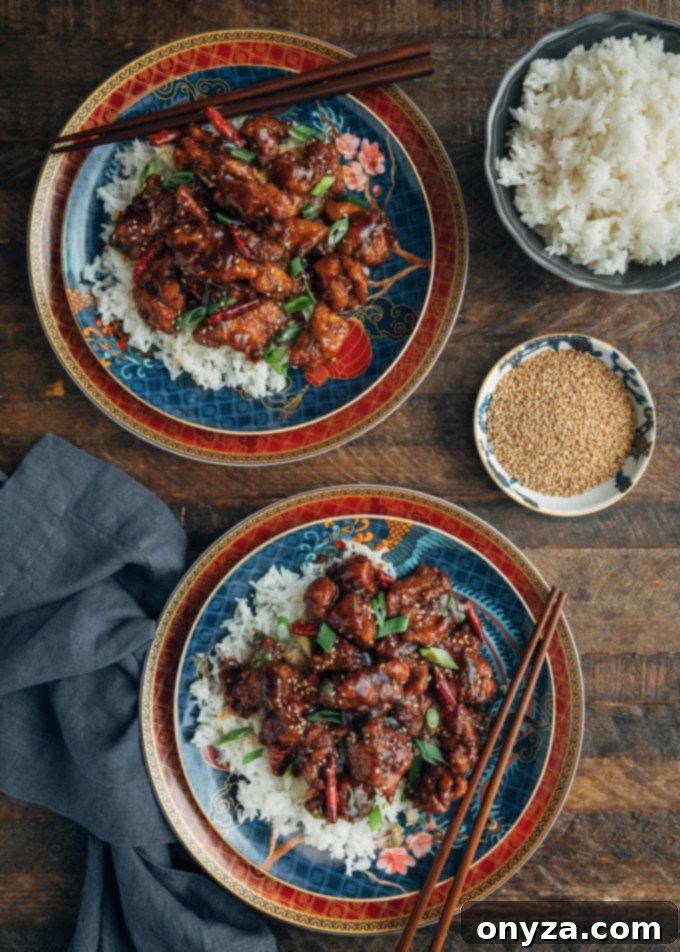Uncover the fascinating story behind General Tso’s Chicken and master the art of creating this beloved sweet, spicy, and savory masterpiece in your own kitchen – a dish so delicious, it rivals (and often surpasses) your favorite takeout!
General Tso’s Chicken stands as an undisputed icon of Chinese-American cuisine. Walk into virtually any Chinese restaurant across the United States, and you’re almost guaranteed to find this distinctively flavored dish prominently featured on the menu. Its popularity is not merely anecdotal; a 2015 study by GrubHub even crowned it the most popular Chinese dish in America. Yet, despite its widespread recognition and seemingly traditional name, General Tso’s Chicken is a culinary enigma, a delicious paradox that isn’t authentically Chinese at all.
This article delves into the intriguing origins of this takeout superstar, tracing its journey from a modest creation in Taiwan to a ubiquitous American favorite. Beyond its captivating history, we’ll equip you with all the essential tips and insights needed to recreate this sweet, savory, and perfectly spicy dish right in your home kitchen. From understanding key ingredients to mastering cooking techniques, prepare to elevate your weeknight meals with a homemade General Tso’s Chicken that’s truly unforgettable.

The Man Behind the Myth: Who Was General Tso?
The name “General Tso” conjures images of ancient Chinese warriors, and indeed, such a figure existed. General Zuo Zongtang (often romanized as Tso Tsung-tang) was a prominent military leader during China’s Qing Dynasty in the 19th century. Renowned for his formidable strategic prowess and his decisive role in quelling the Taiping Rebellion, he was a figure of great influence and, at times, ruthless effectiveness in battle. In his native Hunan province, General Tso is remembered with considerable reverence, his legacy honored through various tributes, including a namesake liquor, a dedicated museum in his ancestral home, and numerous statues.
However, here lies the twist: the iconic General Tso’s Chicken that graces menus across America bears no connection to the historical General Zuo Zongtang. This celebrated dish was never part of his diet, nor is it a traditional culinary offering in Hunan or, for that matter, most of China. In fact, many people living in Hunan today have never even heard of the dish. This surprising disconnect highlights the distinct evolution of Chinese-American cuisine, a culinary genre that often diverges significantly from its regional Chinese inspirations.

Tracing the Culinary Journey: The Origins of General Tso’s Chicken
The true genesis of General Tso’s Chicken is a fascinating tale that sheds light on the broader development of Chinese-American cuisine. This culinary journey was brilliantly chronicled in the acclaimed documentary, “The Search For General Tso,” a film lauded at festivals like Sundance and Tribeca for its insightful exploration. The documentary reveals that the dish originated not in mainland China, but in Taiwan, during the mid-1950s. Its creator was a Hunanese chef named Peng Chang-kuei, who sought to adapt traditional Hunanese flavors for a different palate.
Chef Peng’s original creation was a distinctly spicy and tangy fried chicken dish, deeply rooted in the fiery culinary traditions of Hunan province, characterized by its abundant use of hot peppers. However, the version of General Tso’s Chicken that became a sensation in the United States underwent a significant transformation. In the 1970s, Chef Tsung Ting Wang introduced a variation of the dish to New York City’s Hunam restaurant. Recognizing the preferences of American diners, he made a pivotal alteration: the addition of sugar. This sweet dimension, a less common flavor profile in traditional Hunanese cooking, transformed the dish into the sticky, sweet-and-spicy glazed chicken that is now globally recognized and beloved. This adaptation perfectly illustrates how Chinese-American cuisine often evolves to cater to local tastes, creating entirely new, yet distinctly delicious, culinary experiences.

Mastering Homemade General Tso’s Chicken: A Step-by-Step Guide
Recreating General Tso’s Chicken at home is not only achievable but immensely rewarding. One of the greatest advantages of preparing this dish yourself is the complete control you gain over its flavor profile, especially the level of sweetness. While a touch of sweetness is integral to the Chinese-American rendition, many restaurant versions can be overwhelmingly sugary, often masking the complex nuances of the sauce. By making it yourself, you can strike the perfect balance, allowing the spicy, tangy, and savory notes to shine.
The foundation of an excellent General Tso’s Chicken lies in its components. We start with succulent dark meat chicken, typically boneless, skinless chicken thighs, cut into bite-sized cubes. These pieces are first marinated to tenderize and infuse flavor, then coated in a starch – cornstarch or potato starch works beautifully – before being deep-fried to a golden, crispy perfection. This crisp exterior is crucial for texture. The freshly fried chicken is then quickly tossed in its signature sauce: a dynamic blend of sweet, spicy, and tangy flavors, brought to life with dried hot peppers and the indispensable Chinkiang vinegar.
For unparalleled depth of flavor, **Chinkiang vinegar is an essential ingredient you absolutely shouldn’t skip in this recipe.** This Chinese black vinegar offers a rich, malty, and slightly smoky tang that is distinct from regular white rice vinegar. Its unique complexity elevates the sauce from merely good to truly exceptional, providing that authentic umami dimension found in the best Chinese-American dishes. While rice vinegar can provide acidity, it lacks the profound character that Chinkiang vinegar imparts, making it well worth seeking out for this recipe and other Chinese cooking adventures.
Adjusting the Spice Level to Your Preference
Customizing the spice level is one of the joys of cooking General Tso’s Chicken at home. For a moderate heat that’s family-friendly yet still delivers a delightful kick, I recommend using dried Arbol peppers. These chilies provide a vibrant heat without the intense, lingering burn of, say, Chinese Tien Tsin peppers. To further manage the spice, you can remove the seeds from the Arbol peppers before adding them to the sauce, as the seeds contain most of the capsaicin responsible for heat.
If you opt for particularly potent dried peppers, or if you prefer a subtle hint of spice rather than direct heat, you can remove them from the sauce before serving. Simply place one or two on top of the finished dish purely as a garnish. Rest assured, their heat will have fully infused into the sauce during the sautéing and simmering process, leaving behind a warm, aromatic flavor.
For those who prefer a completely mild dish, fear not! You can easily omit the dried chilies entirely. Even without the peppers, the sauce retains a wonderful balance of sweet and tangy flavors, with a lovely depth from the soy sauces and Chinkiang vinegar. It’s a testament to the versatility of this recipe, allowing everyone to enjoy this classic, regardless of their spice tolerance. As a child, I always requested “not spicy” General’s Chicken from our local takeout spot, proving this milder version is a long-standing favorite!

The Perfect Pairing: Serving General Tso’s Chicken
To truly savor the magic of homemade General Tso’s Chicken, timing is key. For the absolute best experience, serve the dish immediately after the crispy chicken has been tossed in the glossy sauce. The sauce, while delicious, will gradually soften the chicken’s crispy coating as it sits. This applies equally to any leftovers; just like your favorite takeout, refrigerated and reheated General Tso’s will still be flavorful but won’t retain the same delightful crispiness. Embrace the fresh-cooked moment for peak texture and taste!
A common accompaniment in many Chinese-American restaurants is steamed or stir-fried broccoli. This practice is another interesting departure from Chef Peng’s original Taiwanese creation, which was typically served without vegetables. Today, it’s a popular presentation, often seeing the glistening chicken nestled in the center of the plate, encircled by vibrant green broccoli florets. The crisp-tender broccoli provides a refreshing counterpoint to the rich, saucy chicken, adding both color and a healthy vegetable component to the meal.
While many enjoy broccoli with General Tso’s, I personally prefer it as part of a stir-fry, like a classic Beef and Broccoli. For General Tso’s Chicken, my ideal serving is over a generous bed of fragrant jasmine rice. The delicate aroma and soft texture of the rice perfectly absorb the savory-sweet sauce, complementing the crispy chicken without distraction. A final flourish of toasted sesame seeds and thinly sliced scallions adds a beautiful pop of color, a nutty undertone, and a fresh, mild oniony bite that truly completes the dish.
The beauty of cooking at home lies in the freedom to customize. Whether you prefer your General Tso’s Chicken with or without broccoli, fiery hot or wonderfully mild, the kitchen is your canvas. This recipe provides a fantastic foundation, allowing you to tailor the serving experience to suit your family and friends, making every meal a personalized delight.
Looking to create an entire takeout-themed feast at home? Be sure to explore my complementary recipes for Crispy Fried Wonton Strips, Comforting Wonton Soup, and Savory Shrimp Lo Mein!

General Tso’s Chicken
It’s easy to make restaurant-quality General Tso’s Chicken at home! You can have this takeout classic on the table in less than an hour, prep to finish.
30 minutes
20 minutes
50 minutes
4 servings
Ingredients
Chicken
- 1 pound boneless, skinless chicken thighs, cut into 3/4- to 1-inch cubes
- 1 large egg white
- 1 tablespoon Shaoxing wine
- 2 teaspoons light soy sauce
- 1 teaspoon dark soy sauce
- Pinch ground white pepper
- ¾ cup cornstarch
- 4 cups vegetable oil or peanut oil
Sauce
- ⅓ cup low sodium chicken broth
- 2 tablespoons Shaoxing wine
- 1 tablespoon Chinkiang vinegar (Chinese black vinegar)
- 2 tablespoons light soy sauce
- 1 teaspoon dark soy sauce
- ½ teaspoon toasted sesame oil
- 3 tablespoons granulated sugar
- 2-1/2 teaspoons cornstarch
- 1 tablespoon vegetable oil or peanut oil
- 6-8 small dried red chiles, such as Arbol (broken in half and seeds removed)
- 2 teaspoons finely minced or grated ginger
- 2 teaspoons minced garlic
- ¼ cup thinly-sliced scallions
- Toasted sesame seeds, for garnish (optional)
Instructions
Make the Chicken
- Whisk egg white in a bowl until just frothy. Stir in Shaoxing wine, light and dark soy sauces, and ground white pepper. Add cubed chicken thighs and stir to combine. Let marinate for 20 minutes.
- Coat marinated chicken pieces in cornstarch on all sides.
- Heat oil to 350 degrees F in a large wok or a wide, deep, heavy-bottomed pot. Fry chicken in 3 batches until golden, crispy, and centers register 165 degrees F on an instant read thermometer, about 3-4 minutes. Remove chicken from oil with a spider strainer or a slotted spoon and drain on a paper towel-lined plate.
Make the Sauce
- In a bowl, whisk together chicken broth, Shaoxing wine, Chinkiang vinegar, light and dark soy sauces, sesame oil, sugar, and cornstarch. Season to taste with salt and set aside.
- If using the frying vessel to make the sauce, very carefully remove frying oil from the wok or pot. Otherwise, you can use a large skillet for the sauce.
- Heat the clean wok or skillet and add 1 tablespoon of vegetable oil. Sauté dried chiles, ginger, and garlic until fragrant, about 1-2 minutes. Stir the sauce mixture to redistribute any settled cornstarch and pour it into the pan. Bring to a boil and simmer, stirring often, until thickened and glossy, about 2-3 minutes.
- Add fried chicken and scallions to the sauce and toss to coat. Garnish with toasted sesame seeds and serve with jasmine rice and steamed broccoli, if desired.
Notes
If using peanut oil, please refer to allergen notes here. It’s always good practice to inform guests when peanut oil has been used.
1 tablespoon of Chinkiang vinegar will yield a sauce similar to popular Chinese-American restaurant versions. For a tangier sauce, closer to Chef Peng’s original vision, you can increase the vinegar to 2 tablespoons.
Nutrition Estimate
Calories: 572kcal | Carbohydrates: 34g | Protein: 25g | Fat: 36g | Saturated Fat: 26g | Cholesterol: 107mg | Sodium: 963mg | Potassium: 358mg | Sugar: 9g | Vitamin A: 290IU | Vitamin C: 1.9mg | Calcium: 17mg | Iron: 1.4mg
Nutrition information is automatically calculated and should be used as an approximation only.
About Our Recipes
Please note that our recipes have been developed using the US Customary measurement system and have not been tested for high altitude/elevation cooking and baking.
